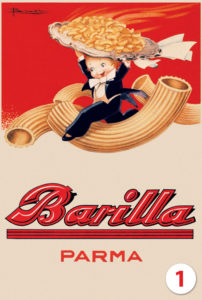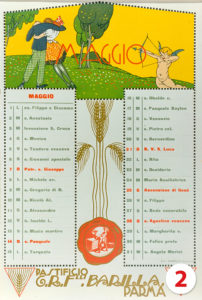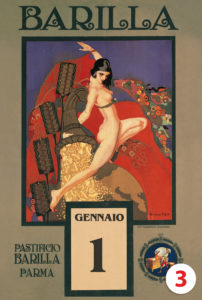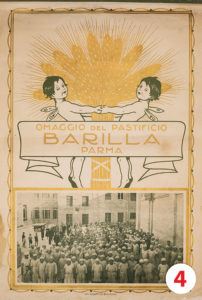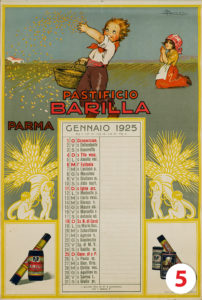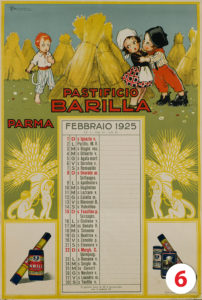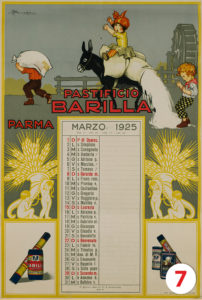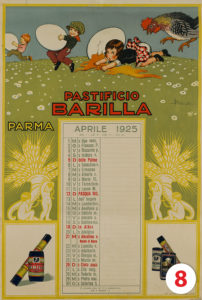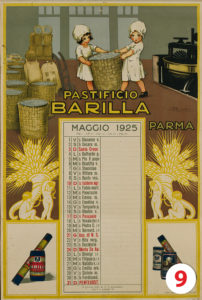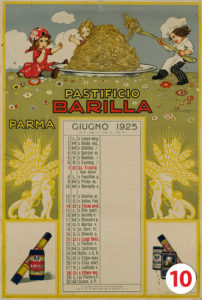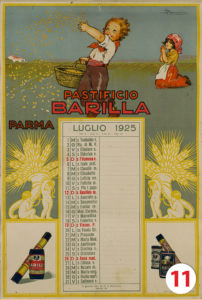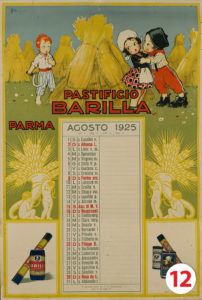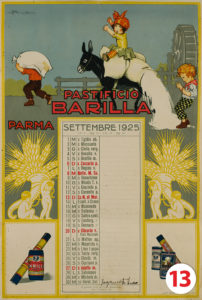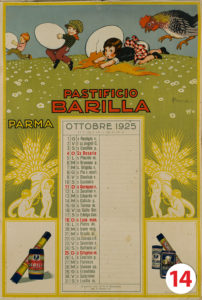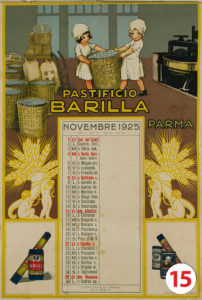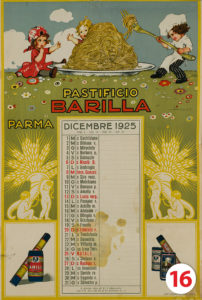The first calendar by Adolfo Busi (1925)
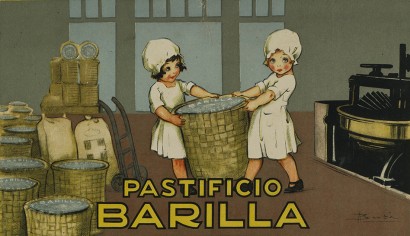
by Giancarlo Gonizzi
An earthquake is never a pleasant thing. It creates damage, destruction and often makes casualties. In May of 2012 the entire area of the lowlands between Reggio Emilia, Modena, Ferrara, Rovigo and Bologna was affected by a prolonged series of tremors that impacted the small historical towns in the countryside of Emilia very heavily. But sometimes even something like an earthquake can lead to unforeseen discoveries.
In 2015 the archives received the phone call from a private library in Mirandola, in the province of Modena. After the earthquake, the necessary clearing operations lead to the “discovery” and the retrieval of a calendar published by Barilla before World War II. Oddly, this had remained stuck behind a bookshelf: could it be of interest to us?
– Could you describe it?
– Well, there are children playing with pasta…
– It could be the calendar by Adolfo Busi. Is there an image of a waiter with a tray filled with macaroni? (Photo 1)
– No, there are children playing with a hen.
– A hen?
I did not recall any Barilla calendar with a hen in it…
– Could you take some photos with your cell phone and send them to us? This way we can tell you immediately if we already have a copy at the archives.
– We will do it as we speak…
A few minutes later an e-mail delivered to us some unexpected photos: a cover that was never seen before with a photo taken by Alberto Montacchini (1894-1956) showing Barilla workers in 1923, enclosed in a golden frieze and surmounted by the design of two winged putti dancing around a large bundles of sheaves.
In the centre, the writing “A gift of Barilla Pasta Factory – Parma”. Then inside, we found unusual images of funny children in farmers clothing intent in sowing wheat, kissing among the sheaves after harvesting, carrying sacks of fresh ground flour from a mill, stealing eggs while happily running in a field. There was a picture of an angry rooster ready to chase a poor girl who fell on the ground and broke her precious booty of eggs, and two small shop apprentices intent in packaging pasta inside corbelli crates – baskets made of chestnut bark used for shipping by train – and more, a baby chef attacking a huge plate of pasta with a gigantic fork.
– How wonderful! But are there only six pages, from January to June?
– No, no, there are twelve months, but the drawings from the first semester are repeated from July on. Are you interested?
We truly were. It was the first legendary calendar made for Barilla by Adolfo Busi (1891-1978), designer from Bologna, and the signature did not leave any doubts. We had heard of its existence from Mrs. Liliana in 1992, but we had never seen it. This too, like the calendars of 1922 (Photo 2) and 1923 (Photo 3), was printed by the Chappuis Printing Shop of Bologna, one of the most prestigious commercial printers active in Italy at the beginning of that century. Thanks to the entrepreneurship of Edmondo Chappuis (1874-1912), the printing plant had become the reference point for the most important poster board designers of the time – from Marcello Dudovich to Hoenstein to Mataloni, Chini, Terzi, De Carolis, and Ballerio. For an entire decade, Bologna represented a research laboratory for new expressive means in graphic design and figurative arts until 1912. With the death of Edmondo, the brothers continued the activity on a lesser tone until 1927.
– If it was possible to us to help their Library with a contribution, since this material was not in the inventory and it was not book material, we could go to Mirandola to pick it up.
And so we made a trip together with our diligent helper Roberto to the land of the great humanist Giovanni Pico (1463-1494), who is remembered for the story of his prodigious mnemonics. We left our car parked just out of the centre of town and entered the small village on foot. We visited the Library, filled with texts and documents of the glorious history of that land, and we admired the calendar that came back with us to take his honoured place in the Archives. (Photo 4-16)
Time left its traces and the metal staples that held it together were now covered with rust. One page had detached, the corners had been eaten away by some parasites…Restoration work was in order. Thus, in 2019, our precious expert Lorena took care of the only known specimen of the 1925 Barilla calendar.
Cleaning, disinfestation and filling of gaps in areas gave new life to the colours and illustrations of the designer from Bologna. As Pietro Barilla recalled, that calendar had been a successful one, and for that reason the Company called Busi to make a new edition in 1931. In those five years, though, the world had changed: Futurism and its polemic against pasta lead to the making of a masterpiece. The precious document of 1925 served to fill missing information and to complete years of research. The birth place of the genius of mnemonics contributed to enrich the historical memory of Barilla. We could truly celebrate this with a spaghetti party, like the baby chef of the month of December in our calendar invited us to do…
